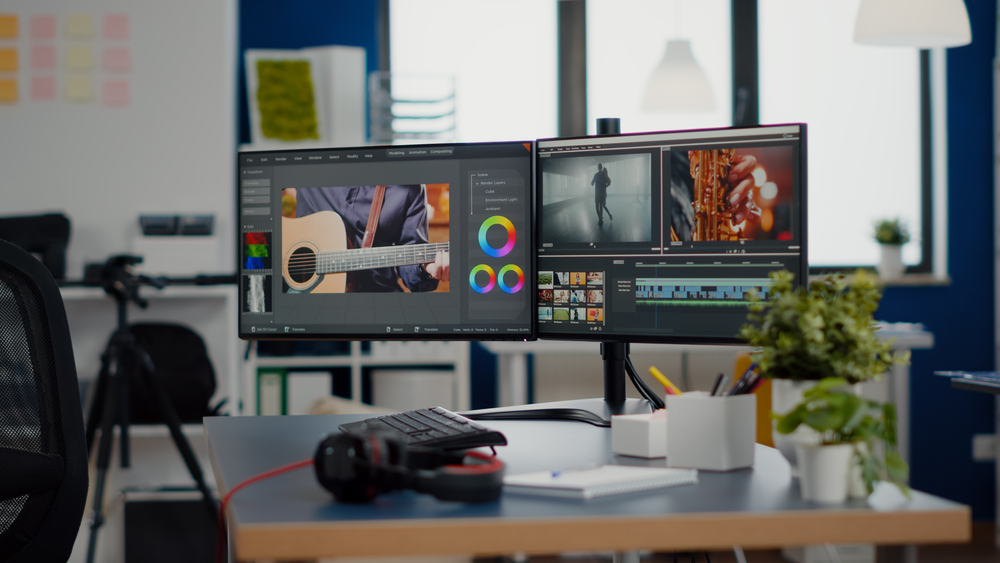Have you ever had a project where you felt like you needed to take it to the next level and make it the best it could be? Have you ever wanted a specific shot in your video, but didn't know how to go about it? Maybe you want to fly a drone over an amazing vista but are unsure how to do so. Creating a detailed checklist for these types of projects will help ensure things go smoothly for your team. Having a comprehensive understanding of industry-standard video post-production steps will help you create an excellent end product that will stand out from the rest!
Our fast-moving world has been ever-demanding on video content and it has become evident that these changing habits are driving video and audio content to new heights. The video and audio content consumption rate has now hit an all-time high and they are the most popular and preferred mode of communication among audiences around the world. But is your post-production workflow achieving the best results? We are sharing the tried and tested workflow we have successfully adopted in Creative Hive Studios. Here is a comprehensive guided walkthrough to declutter your post-production workflow and upgrade your video content to help them reach their full potential.
What is a Post-Production Workflow?
There are three vital phases when it comes to creating video and audio content and post-production is the third and final stage of video creation. It is preceded by pre-production (first phase) and production (second phase) respectively. Post-production is usually the stage after production when the shooting is done and the editing of the filmed/recorded video and audio material begins. Post-production generally involves Editing, Colour Grading & Correction, Visual Effects & Animation, Sound Recording, Foley Recording, Script Sound Recording, Sound Mixing & Editing, Soundtrack & Music.
The Quintessential Stages in Post-Production Workflow
Let us dive into some of the critical and important stages of post-production that will help you achieve a foolproof plan to nail an awesome video content. Post-production workflows can vary depending on whether you're creating a video or audio project. Below is a brief summary of each major step.
Story Clarity and Planning
As Walt Disney once said, “A good story can take you on a fantastic journey” and this is perhaps the most fundamental aspect of a good post-production workflow. Story forms the bedrock of your video. The story captures the attention of the viewers and motivates them to watch your video till the end. A video that exhibits a captivating story-telling quality is truly an asset for all content creators. But to ensure a seamless translation of the story clarity, it is important that you should have a clarity about the story that you want the audience to see and feel. Make sure that your team completely understands the story and everyone is on the same page. You could try to make use of the storyboard and which would help them understand your story better. This would help them stay on track and work towards the common goal of taking appropriate measures to make your video’s story create a substantial impact on the target audience.
Logging and Importing your Footages
For every minute spent organizing, an hour is earned. Post-production is no exception to this golden rule that saves you from a lot of hassle and last minute confusions. Get your media organized from the start. A good, effective video editor depends on effective media management. You should go through and organize all your clips, cut out all the non-useable parts and ensure as many good options as possible. Once you've decided which files to use for your video, import them into your project. You can then organize your footages into folders or "bins" to organize them in the way that works best for you.
Editing (Rough Cut, First Cut and Fine Cut)
Editing is the process of selecting and arranging video clips to create a final video product. It's an important part of your post-production process, but it can also be intimidating if you're new to the business. Edits are generally done after all other elements of your project have been completed and approved by clients, so it's best to start editing as soon as possible after shooting or recording the footage.
After organizing your clips, it is time to create the rough cut. The rough cut’s primary goal is to make the closest possible version of the director’s original intentions. Make sure that you cover shots from all angles and desired camera movements (at least one instance from each) without changing any script lines or the original sequence of lines or scenes. The first cut is the rough cut agreed upon by the editors, directors and producers. The selection and order is mostly fixed, although changes can still be made. And finally the fine cut no longer focuses on the entire film, but on the details of each cut. Subtle editing accentuates and consolidates the flow and structure established in the first cut.
Colour correction and Colour Grading
Colour correction is the process of balancing the colour in your footage, so that it matches the look you are trying to achieve. This can be used for both artistic and technical reasons. For example, if you want a specific colour effect on your video (like a green screen), then colour correction will help you achieve this look by adjusting the saturation levels and shadows/highlights/contrasts of various parts of your video. Grading is the process of adjusting the colour of your footage to make it look more artistic and intimate according to your taste. It's a subjective process and you can't always automate it, but grading is still extremely important because it will help with overall clarity and quality perception in your final product.
Adding Visual Effects
As your perfectly trimmed and polished edit is now ready, it is now time to add corrections, augmentations and visual effects. Visual effects are a great way to enhance a video. They can be used to create new looks or feel, remove unwanted elements and add elements to your video. Adding visual effects denotes an essential final step for any film.
.
Sound Design and Sound Mixing
Sound design is a vital part of video post-production. It's the process of adding sound to your video, whether it be music or dialogue. Sound design can be used to create mood, add tension and more. Sound mixing is the final step in post-production. It's where you can add music, sound effects and fade-outs to bring your video to life. Here you might want to focus a lot on cleaning up any sounds that need to be filtered from unwanted background noise as much as possible. Sound mixing is also known as "mixing" or "post-production." It's when you add all of your audio tracks together so they blend together seamlessly.
Generating Titles and Credits
Titles and credits are important to the viewer and it’s time to add them to the beginning and end of your video. Make them groovy and catchy so that they leave an impression on your viewers. If you are making videos to promote your business, make sure you have a call to action. Don't forget to include links in your video. To your website, social media accounts and email addresses for people who want more information about you or your company.
Export the Final Out
Once your video is ready to be exported, it's time to do so. You'll need to decide what format you want your finished export in before exporting the file. The most common formats are .mp4 and .MPEG-4 AVC High Profile (H.264/AVC), which allows for better compression than other formats like .mov or .mpeg. MP4, a newer format that offers better quality than the older MPEG-4 ASP (Advanced Simple Profile) format has been adopted by some mobile platforms such as Apple iOS devices or Android OS phones/tablets when they want high-resolution audio and video content. Most of the time, you will have to export an array of final cuts of varying formats as this helps you to share the video on different channels/platforms
Conclusion
While every aspect of filmmaking is important, post-production is an important turning point in any movie or film. If executed properly, this process can pretty much guarantee you a deep and prolonging connection with your audiences. With these tools and a post-production checklist, you can be on your way to complete a strong and cohesive film

